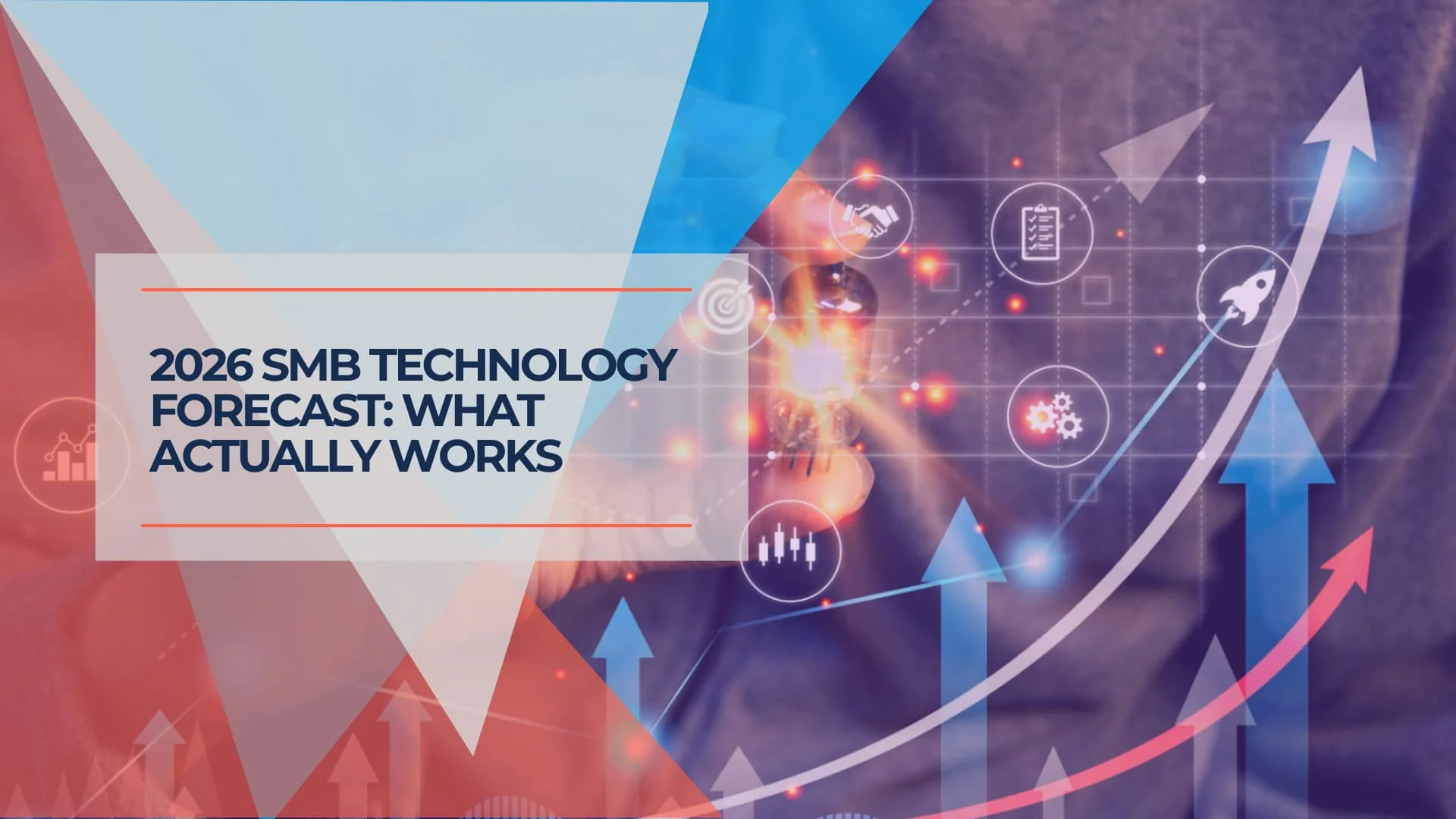The 2025-2026 Small Business Technology Forecast
Data-driven SMB technology forecast based on 50+ implementations. Five trends defining 2025-2026: multi-gig infrastructure, tech stack consolidation, simplified security, practical AI, and marketing fundamentals.


Key Takeaway
After analyzing data from 50+ small business technology implementations over the past 18 months, five clear trends emerge for 2026. Multi-gig infrastructure, technology consolidation, simplified cybersecurity, practical AI adoption, and fundamentals-focused marketing strategies will define successful SMB technology investments through 2026.
Affiliate Disclosure: This article contains affiliate links. If you make a purchase through these links, we may earn a small commission at no extra cost to you.
Our Methodology: Real-World Data Over Vendor Hype
This forecast analyzes actual client implementations rather than vendor surveys or industry predictions. Our data comes from network deployments, security assessments, and technology consulting projects completed between April 2024 and September 2025 across Miami-Dade and Broward counties.
Unlike technology forecasts that rely on vendor roadmaps or analyst predictions, we focus on what small businesses actually implement, when they implement it, and what drives their decisions. This ground-level perspective reveals adoption patterns that often differ significantly from industry hype cycles.
Our analysis includes businesses with 5 to 65 employees in the healthcare, professional services, manufacturing, retail, and hospitality sectors. Budget data reflects actual project costs, not vendor list prices or theoretical ROI calculations.
The Five Technology Shifts Defining 2025-2026
1. Multi-Gig Infrastructure Becomes Business Standard
Adoption Timeline
- Current (Q4 2025): 45% of new network deployments include multi-gig capability
- Q2 2026: 70% of business network upgrades
- Q4 2026: Standard specification for business networking
- 2027: Multi-gig becomes the minimum expectation
Confidence Level: 85% – Based on current deployment patterns and cost trends
Multi-gigabit networking represents the most significant infrastructure shift we've observed. In early 2024, fewer than 20% of our clients requested multi-gig capability. By September 2025, this figure reached 45% for new deployments and 30% for network refreshes.
The driving factors extend beyond internet speeds. Businesses understand that multi-gig infrastructure future-proofs their investment as applications become more bandwidth-intensive and file sizes grow.
Key Implementation Observations:
- 2.5G switching is becoming the minimum specification rather than an upgrade option
- Wi-Fi 6E and 7 deployments requiring multi-gig backhaul for optimal performance
- PoE++ requirements are increasing with new camera and access point generations
- Cost differential with gigabit infrastructure now under 15%
Real-World Results:
- Businesses report 35-50% faster file transfers after multi-gig upgrades
- Video conferencing quality improvements are particularly notable in multi-participant meetings
- Future-proofing value is recognized as applications become more bandwidth-intensive
- ROI is typically achieved within 12-18 months through productivity gains
For businesses planning their network infrastructure, modern UniFi network solutions such as the UniFi UDM Pro MAX gateway and the UniFi Wi-Fi 7 lineup offer multi-gig capabilities with enterprise-grade management at small to medium-sized business price points.
Budget Impact: Multi-Gig Infrastructure
- 15-person office: $3,200-4,800 total network upgrade
- 25-person office: $5,500-8,200, including switching and cabling
- 50-person office: $12,000-18,000 comprehensive deployment
- Typical ROI: 12-24 months through productivity improvements
2. The Great Technology Stack Consolidation
Adoption Timeline
- Current (Q4 2025): Subscription audits and cost analysis are widespread
- Q1 2026: Platform consolidation planning peak
- Q3 2026: Major platform migrations complete
- 2027: Simplified, integrated technology stacks standard
Confidence Level: 80% – Clear pattern emerging across client base
Subscription fatigue reached a breaking point in 2025. The average 25-person business we analyze manages 32 different software subscriptions, with 18% functional overlap and $1,800 in annual redundant spending.
Smart businesses are consolidating around platform ecosystems rather than continuing to add point solutions. This shift reflects their priorities in cost management and operational efficiency.
Platform Consolidation Patterns:
- Communication platforms: Teams vs Slack winner-take-all decisions
- Productivity suites: Microsoft 365 vs Google Workspace rarely coexist
- Security solutions: Unified platforms replacing security tool sprawl
- Business applications: All-in-one CRM/project management adoption
Why Consolidation Works:
- Business owners want "one contact point" when systems fail
- Platform ecosystems reduce training complexity and user confusion
- Integration between tools improves when staying within a single vendor ecosystem
- Vendor relationship management becomes significantly simpler
Recommended Consolidation Approach:
Start with your largest subscription spend and work down. Map overlapping functionality before canceling services. Most importantly, involve your team in platform selection to ensure adoption success. Document current workflows before making changes to avoid disruption.
Budget Impact: Stack Consolidation
- Typical savings: 20-35% reduction in software costs
- 10-person business: $150-280/month savings
- 25-person business: $380-720/month savings
- Implementation cost: 20-40 hours internal time management
- Break-even timeline: 2-4 months after implementation
3. Cybersecurity Fatigue Drives Simplified Approaches
Adoption Timeline
- Current (Q4 2025): Security tool fatigue and alert overwhelm are widespread
- Q2 2026: Simplified security platform adoption accelerates
- Q4 2026: Managed security services mainstream for SMB
- 2027: Security-as-a-service becomes the default approach
Confidence Level: 75% – Strong demand for simplified solutions observed
Security fatigue is real. Small businesses struggle with complex security tools, frequent alerts, and the administrative burden of maintaining multiple security solutions. This complexity often leads to poor security hygiene or tool abandonment.
Successful security implementations in 2025 emphasize simplicity and automation. The businesses with the best security outcomes use fewer tools, not more, focusing on solutions that work automatically without constant attention.
Practical Security Trends:
- Zero-trust "lite" implementations through solutions like NordLayer
- Email security is becoming non-negotiable with DMARC implementation
- Password managers are finally achieving widespread adoption
- Managed detection services replacing in-house monitoring
- Automated security training reduces administrative burden
Why Simplified Security Wins:
- Automated solutions reduce alert fatigue while improving actual security posture
- Single-vendor security platforms eliminate integration headaches
- Managed services allow focus on business operations rather than security administration
- User-friendly tools achieve higher adoption rates and better security outcomes
The most effective approach combines automated protection with simplified management. Business password managers like 1Password Business exemplify this trend—comprehensive protection with minimal ongoing administration.
Security Implementation Strategy:
Focus on the fundamentals: strong authentication, email security, endpoint protection, and backup systems. Advanced threat hunting and complex security orchestration tools are typically unnecessary for SMBs and create more problems than they solve.
Avoid These Mistakes
- Avoid security tool sprawl – complexity is the enemy of security
- Prioritize solutions with high automation and low maintenance requirements
- Choose tools your team will actually use rather than the most comprehensive options
Budget Impact: Simplified Security
- Comprehensive coverage: $120-350 per employee annually
- 10-person business: $100-290/month total security spend
- 25-person business: $250-730/month for complete protection
- Typical security incident cost avoided: $25,000-150,000
4. AI Adoption Reality Check: Organization Before Automation
Adoption Timeline
- Current (Q4 2025): AI experimentation and pilot projects are widespread
- Q2 2026: Practical AI tools for organized businesses
- Q4 2026: AI workflow integration for structured processes
- 2027: AI becomes a productivity multiplier, not a replacement
Confidence Level: 60% – Highly dependent on business process maturity
The AI adoption pattern we observe differs significantly from vendor predictions. Businesses with organized, documented processes gain substantial value from AI tools. Those with chaotic workflows see minimal benefit and often abandon AI initiatives.
The lesson: Organize your processes before automating. AI amplifies existing efficiency—it doesn't create organization where none exists.
Realistic AI Adoption Patterns:
- Document management and knowledge base creation (first wave)
- Customer service automation for businesses with structured processes
- Content creation assistance for marketing and communications
- Scheduling and workflow triggers for repetitive tasks
- Enhanced security monitoring through AI-powered threat detection
What Works:
- Start small with clearly defined use cases where success is measurable
- AI works best with consistent, repeatable tasks and documented processes
- Gradual scaling shows better results than attempting workflow transformation
- User training and change management are crucial for successful AI adoption
AI Implementation Approach:
Begin with one clearly defined use case where success can be measured objectively. Master that application before expanding to additional workflows. Document your processes first—AI works best with consistent, repeatable tasks.
What to Avoid
- Avoid attempting to transform entire workflows with AI initially
- Don't implement AI in chaotic or poorly documented processes
- Resist vendor pressure to adopt AI before your business is organizationally ready
Budget Impact: Practical AI Integration
- Meaningful AI tools: $40-180 per user monthly
- Implementation time: 3-6 months for first meaningful deployment
- Training investment: 8-15 hours per user for effective adoption
- Expected productivity gains: 15-25% in automated processes
5. Digital Marketing Back-to-Basics Movement
Adoption Timeline
- Current (Q4 2025): Social media algorithm fatigue and declining organic reach
- Q2 2026: Investment in owned media and direct relationships
- Q4 2026: Website performance and local SEO prioritization
- 2027: Simplified marketing technology stacks focused on fundamentals
Confidence Level: 70% – Clear shift toward owned media observed
The constant changes in social media algorithms, search engine policies, and digital advertising platforms drive businesses back to marketing fundamentals: owned media, direct customer relationships, and authentic local presence.
This shift reflects both frustration with platform dependency and recognition that sustainable marketing requires assets businesses actually control.
Marketing Infrastructure Trends:
- Website performance optimization is taking priority over complex funnels
- Email list building and automation are becoming the primary focus
- Local SEO investment for service-based businesses
- Customer review systems integration for authentic social proof
- Social media simplification – fewer platforms, deeper engagement
What Delivers Results:
- Fast, well-optimized websites consistently outperform complex funnels
- Email marketing provides the best ROI for most small businesses
- Local SEO drives higher-quality leads than broad digital advertising
- Authentic customer reviews carry more weight than paid advertising
Businesses that see the best marketing results focus on excellence in fundamentals rather than chasing the latest platform or trend.
Budget Impact: Marketing Technology Optimization
- Core marketing stack: $250-1,000/month depending on business size
- Website performance tools: $80-250/month
- Email and automation: $40-180/month
- Local SEO tools: $80-350/month
- Expected ROI: 300-500% for well-optimized fundamentals
Investment Priority Matrix for 2025-2026
Not every technology investment offers equal returns. Based on our client implementation data, here's how to prioritize technology spending for maximum business impact:
| Priority Level | Technology Category | ROI Timeline | Implementation Risk |
|---|---|---|---|
| Must-Have | Multi-gig network infrastructure | 12-24 months | Low |
| Must-Have | Email security (DMARC/SPF) | Immediate | Medium |
| High Priority | Technology stack consolidation | 3-6 months | Medium |
| High Priority | Password manager deployment | Immediate | Low |
| Medium Priority | Website performance optimization | 6-12 months | Low |
| Medium Priority | Practical AI tool adoption | 6-18 months | High |
| Lower Priority | Advanced marketing automation | 12+ months | High |
Action Planning Framework
Successful technology implementation requires structured planning and realistic timelines. Based on our client success patterns, here's a practical framework for 2025-2026 technology investments:
Q4 2025: Foundation Assessment
- Security fundamentals: Deploy a password manager, implement DMARC, and audit current security tools
- Subscription audit: Catalog all software subscriptions, identify overlaps and unused services
- Network assessment: Evaluate current infrastructure capacity and plan a multi-gig upgrade path
Q1 2026: Strategic Planning
- Platform decisions: Choose primary productivity and communication platforms
- Migration planning: Document current workflows and plan platform transitions
- Network infrastructure: Begin multi-gig network deployment planning and procurement
Q2 2026: Implementation Phase
- Technology consolidation: Execute platform migrations with proper change management
- Infrastructure deployment: Complete network infrastructure upgrades
- AI pilot programs: Begin small-scale AI tool testing in organized business areas
Q3 2026: Optimization and Training
- User adoption: Focus on training and process refinement
- Performance monitoring: Measure results and adjust implementations
- Scaling decisions: Expand successful implementations, discontinue failed experiments
2026 Considerations: Potential Variables
While our core predictions focus on observable trends, several potential developments could impact small business technology adoption:
Regulatory Developments
- AI regulation implementation: Formal requirements for AI tool disclosure and data handling may emerge, particularly in healthcare and finance sectors
- Cybersecurity compliance: Enhanced security standards for businesses handling customer data could become requirements following major incidents
- Data portability policies: Right-to-export requirements affecting platform relationships may reshape software vendor strategies
Technology Development Factors
- Quantum computing progress: Current encryption standards are becoming vulnerable and could require accelerated security infrastructure updates
- Satellite internet maturity: Business satellite services reaching cost parity with fiber could change rural connectivity options
- Edge computing adoption: Local processing power, reducing cloud dependency, might shift infrastructure investment priorities
Economic Environment Considerations
- Interest rate conditions: Financing costs could impact technology investment decisions and delay infrastructure projects
- Remote work patterns: Changes in hybrid work arrangements could require different infrastructure approaches than currently planned
- Energy costs: Power price changes could make energy efficiency a primary factor in technology selection
Getting Started: Your Next Steps
Technology planning can feel overwhelming, but success comes from methodical implementation rather than trying to address everything simultaneously. Start with an honest assessment of your current state.
- Audit your current software subscriptions and identify overlap
- Assess your network infrastructure capacity and performance
- Review your cybersecurity fundamentals and identify gaps
- Document your most repetitive business processes
- Evaluate your website performance and local search presence
Frequently Asked Questions
When should small businesses prioritize multi-gig infrastructure upgrades?
Multi-gig infrastructure makes sense when your current network shows signs of congestion during peak usage, when planning office renovations or expansions, or when implementing bandwidth-intensive applications like 4K video conferencing or large file collaboration systems. However, the cost differential with gigabit infrastructure will essentially disappear in 2025.
How do I know if my business needs technology stack consolidation?
Signs include multiple software subscriptions serving similar functions, employee confusion about which tools to use for specific tasks, data silos between different platforms, or software costs exceeding 12-18% of total operational expenses. Consolidation will likely provide significant benefits if you manage more than 30 software subscriptions.
What's the most cost-effective approach to improving cybersecurity?
Start with fundamentals: implement a business password manager, enable multi-factor authentication on all accounts, establish DMARC email security, and ensure regular automated backups. These foundational steps provide the highest security return on investment and prevent the most common attacks.
Should small businesses wait for AI technology to mature before adopting?
Focus on AI tools that enhance existing, organized processes rather than waiting for revolutionary capabilities. Document management, customer service chatbots for structured inquiries, and content creation assistance offer immediate practical value for businesses with clear workflows. Avoid AI if your processes are chaotic or poorly documented.
How can Miami businesses prepare for hurricane season with their technology investments?
Prioritize cloud-based backups with geographically distributed storage, implement remote access solutions for extended work-from-home capabilities, and consider uninterruptible power supplies for critical network equipment. Storm-resistant network installation practices also reduce recovery time. Our local experience includes hurricane-hardened installations designed for South Florida conditions.
Key Takeaways for Small Business Technology Planning
Final Recommendation
The 2025-2026 technology landscape rewards businesses focusing on fundamentals over flashy innovations. Multi-gig infrastructure, simplified security, platform consolidation, realistic AI adoption, and marketing basics will deliver better returns than complex solutions that promise transformational changes.
Choose technologies that grow with your business rather than solutions you hope to grow into. Successful technology adoption in 2025-2026 will favor practical implementations over ambitious transformations.
Success requires matching technology investments to actual business processes and user capabilities. The most sophisticated tools provide no value if they're too complex to implement effectively or maintain consistently.
Plan incrementally, measure results objectively, and focus on solutions that solve real business problems rather than theoretical efficiencies. Technology should enhance your existing strengths, not attempt to compensate for operational weaknesses.
The businesses that thrive in the next two years will be those that implement technology thoughtfully, focusing on sustainable competitive advantages rather than temporary tactical gains. Start with what matters most to your specific operation, and build systematically from there.
Related Articles
More from IT Guides

When DIY IT Stops Making Sense: The Inflection Points
Calculate the real cost of DIY IT vs managed services. See employee thresholds, warning signs, and when professional support saves money.
19 min read

Managing Windows 11 with Google Workspace: Preventing Unwanted Microsoft Service Integration
Windows 11 automatically enables OneDrive and Edge, conflicting with Google Workspace. Learn practical solutions to control your business environment.
17 min read

Windows 10 End of Support Guide: Your Complete Migration Plan for 2025
Windows 10 support ends October 14, 2025. Get your complete business migration plan with timelines, costs, and step-by-step Windows 11 upgrade guide.
21 min read